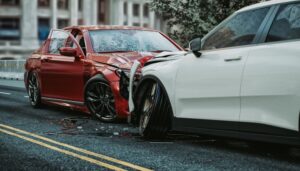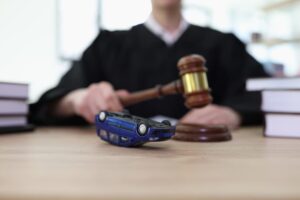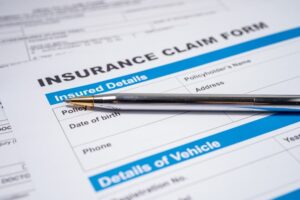When you suffer injuries in a car accident, you may have the opportunity to recover financially. You can secure compensation in various ways based on the circumstances. One of the ways you may need to seek monetary recovery is by going to court. But what happens during the trial, and what can you expect?
Understanding how a car accident trial works and knowing what you can anticipate can help you feel more confident and prepared. You can rely on your Phoenix car accident lawyer throughout the process as they build your case, represent your best interests, and support you from beginning to end.
What is a Car Accident Trial?

When you’re unable to settle your car accident claim outside of court for whatever reason, you can take your case to court. Going to trial starts by filing a personal injury lawsuit.
Car accident lawsuits are a type of civil case in the area of personal injury law. In a civil case, one party, the plaintiff, sues the other party, the defendant, and asks the court for relief. Relief comes in many forms, but for car accident cases, plaintiffs ask the court for monetary relief to cover their expenses and losses.
During a car accident trial, the plaintiff and the defendant present their cases before a fact finder. The fact finder may be the judge if it’s a bench trial, but in many accident cases, the fact finder is a jury.
Once both sides present their cases, the fact finder makes the determination. One said “wins,” and the other “loses,” meaning one party can reach its objective while the opposing party suffers some sort of loss.
Do All Auto Collision Cases Go to Court?
TV and movies might make you think every civil case goes to trial, but that’s not true. Not all civil lawsuits, like personal injury lawsuits, go to court.
In fact, in most cases, personal injury lawsuits are resolved and settled before they ever reach the courtroom. Still, under certain circumstances, settlement is not in the cards, and going to trial is the best way to pursue favorable compensation.
Regardless of whether your car accident case goes to trial, your car accident lawyer will do what is best for your case. If your attorney believes taking your case to trial is best, you can rely on their legal experience.
Reasons Why Some Car Accident Cases Go to Trial
As mentioned, most car accident cases never make it to trial. However, in certain situations, cases do go to trial for various reasons.
Usually, a collision case goes to court because:
- The insurance company does not offer a just settlement
- The insurance company unfairly denied a collision claim
- The insurance company is not willing to settle your claim fairly despite negotiation talks with your attorney
- There is a dispute regarding fault for the accident
Going to trial allows you to continue pursuing fair compensation, but attorneys try to avoid it as it can burden everyone involved. A trial can be time-consuming and costly, so, in most cases, lawyers try to hash it out without going to court. Still, in some cases, you cannot get on the same page, and you must go to trial.
What To Expect During a Car Accident Trial

Going to trial can be stressful, especially if you don’t know what to expect. Your car accident lawyer can prepare you for what’s to come and walk you through the process so you feel more at ease.
Every case is different, and situations vary. However, the following is what you can potentially anticipate during a trial for your car accident case.
Jury Selection
If your trial is a jury trial, the first step is jury selection. Jurors play a substantial role in car accident trials, so the selection process is crucial. Depending on your state, juries can consist of six to 12 jurors.
During jury selection, the judge and attorneys can speak with potential jurors and ask essential questions to determine their eligibility to serve. Gauging biases and prejudices is vital to having an impartial jury.
Once the jury is selected, the members take an oath promising to reach their verdict solely based on the court’s instructions and the evidence they’ll see at trial.
Opening Statements
On the first day of your car accident trial, attorneys on both sides have the floor to make their opening statements. Opening statements allow attorneys to give the jury a glimpse into what they can expect to see during the trial and what they anticipate their arguments and evidence to show.
Usually, the plaintiff goes first. Plaintiffs have the burden of proof, meaning they’re responsible for providing proof of their assertions. For example, the plaintiff must show by a preponderance of the evidence that the other party’s negligence caused their accident and resulting injuries and losses.
The defendant can do the same once the plaintiff makes their opening statement.
Presentation of Evidence and Testimony
Following opening statements, the plaintiff and defendant proceed with presenting their cases.
Once again, the plaintiff goes first since they have the burden of proof in the case.
As such, the plaintiff’s attorney makes their argument and offers supporting evidence, testimony, and documentation, which can include:
- Testimony by the plaintiff detailing the accident, including how it happened and the injuries and property damage resulting from the collision
- Testimony by witnesses and experts
- Medical records and bills
- Photographs and video exhibiting the accident itself, the scene, property damage, and injuries
Defendants don’t typically present as much evidence as plaintiffs since the burden of proof is not on them. However, the defense can present its arguments to rebut the plaintiff’s claims and introduce contradictory evidence and testimony. The defense aims to undermine the plaintiff’s case and bolster their own.
Both sides can question their own witnesses, a process called direct examination. Additionally, opposing parties can question each other’s witnesses, a process called cross-examination.
This portion of the trial is the most time-consuming. Once both sides have presented their arguments and all supporting evidence and testimony, parties move on to closing arguments.
Closing Arguments
The closing argument is the last chance for the plaintiff and the defendant to try to convince the jury to reach a verdict in their favor. They use this time to remind the jury what they’ve seen and heard and highlight key details concerning their case.
Jury Deliberation
After hearing arguments and closing statements, the jury moves into a special room to discuss the case. The goal of deliberation is to discuss the case, including the details and evidence presented, and agree on the verdict.
Juries can deliberate as long as they need. Deliberations may last a few hours, but in complicated cases, deliberations can last several days. Only the jury is present during deliberations, and no other party participates.
The jury picks a foreperson to act as its spokesperson. The foreperson is tasked with leading deliberations, communicating with the judge, and delivering the verdict.
The Verdict
Once the jury reaches its verdict, the foreperson communicates this to the judge. The judge, jury, and parties reconvene for the verdict's reading, which is made part of the court’s official record.
How Long Does a Car Accident Trial Last?
Many car accident trials only last a few days. More complex cases with extensive injuries and property damage, can take longer.
What Comes Before a Collision Case Goes to Trial?
As you can imagine, you don’t just skip ahead to trial after a car accident. Many steps come before filing your lawsuit and going to court. It’s also important to understand these steps, as they play a crucial role in your case and the overall process.
Filing a Collision Claim

Depending on the details of your accident, you may begin your pursuit for compensation by filing an insurance claim. Usually, if your collision involves an insured driver, you can take this route to seek financial recovery.
The insurance claim process depends on your state’s fault laws. If your accident occurred in a fault state, you can file a third-party claim with the at-fault driver’s insurance. Fault states require proof of the driver’s fault. On the other hand, if your state is a no-fault state, you will file a first-party claim with your own insurance company. Proving fault right away isn’t necessary, but if it is later discovered the other party was responsible, your insurer can seek reimbursement from that party’s insurer.
Sometimes, filing a collision claim is all that’s needed to reach a fair settlement. If, after their investigation, the insurance company approves your claim, they may offer a just settlement for your claim, which you can accept.
Unfortunately, obtaining financial recovery from the insurance company isn’t so simple. The insurance company may deny your claim or make an unfair settlement offer. Even if the insurance claim doesn’t yield favorable results, you may have other options.
Sending the Insurance Company a Demand Letter
If the insurance company is not cooperating, your attorney can send them a demand letter. A demand letter is one of the many legal tools car accident lawyers use to reach an advantageous settlement for your claim.
In the demand letter, your lawyer includes important information concerning your collision, including details about the accident and your resulting injuries and proof of their insured’s liability. At the end of the letter, your attorney includes a dollar amount representing the value of your claim and “demands” the insurance company settle for said amount.
Upon receipt of the letter, the insurance company has the option to settle your claim for the requested figure or engage in settlement negotiations with your attorney. If the insurance company refuses to settle, your lawyer can take further legal steps.
Filing a Personal Injury Lawsuit
Your accident attorney can draft your petition and file it, along with supporting documentation and appropriate fees, with the court. Within your petition, your lawyer includes information about your accident and details the relief requested.
Once the opposing party is served with copies of court documents, they have a short time to file their response to your allegations with the court. After they have made their court filing, the lawsuit can proceed.
Going Through Discovery
Discovery is one of the most important parts of a car accident lawsuit. During this phase, parties can build their cases and request and obtain pertinent information from the opposing party. Certain legal tools, including requests for production and depositions, aid in discovery.
The discovery process is also commonly the most time-consuming. Based on the case's complexity, discovery can last from a few weeks to many months.
Settlement Negotiations
At the end of discovery, parties are typically better equipped to revisit settlement negotiations. Negotiations may take some time as attorneys try to work out a mutually beneficial agreement. At this stage, many car accident cases settle. If a case is unable to settle, it moves forward with trial.
Statutes of Limitations for Car Accident Cases
Your state’s statute of limitations can substantially affect your claim and ability to obtain compensation. A statute of limitations is a law that restricts the time you have to file your lawsuit in court. Depending on your state’s laws, you may only have one to six years to take legal action for your auto collision.
Because there are so many pre-lawsuit steps to take, it’s crucial to get started on your claim immediately to avoid missing your opportunity to file it. Failing to file your lawsuit on time can prevent you from continuing your case and reaching the result you deserve.
A Car Accident Attorney Can Provide Quality Representation at Every Stage of Your Case
Taking your case to trial can be unsettling, but when you have a skilled, experienced car accident attorney on your side, the process doesn’t have to be so daunting.
Consult a local lawyer as soon as possible following your collision. The sooner your attorney begins working on your case, the closer you are to going to trial, if necessary, and obtaining just financial recovery.
Consult a local personal injury attorney as soon as possible following your collision. The sooner your attorney begins working on your case, the closer you are to going to trial, if necessary, and obtaining just financial recovery.